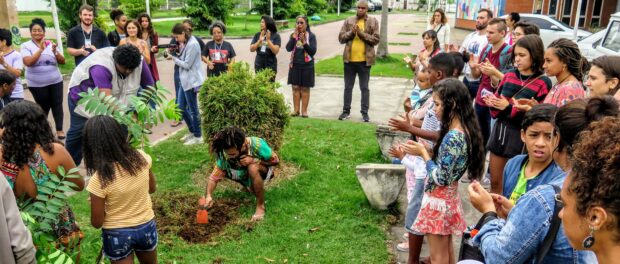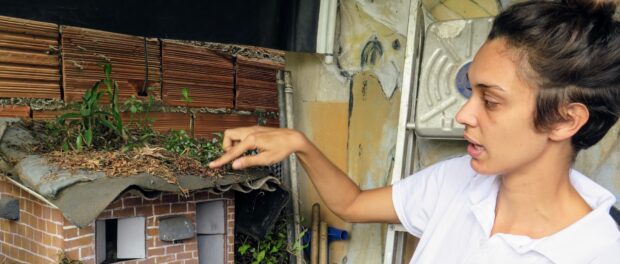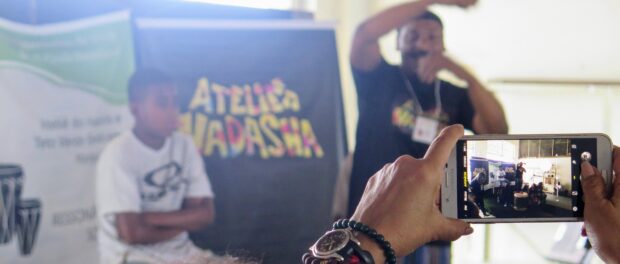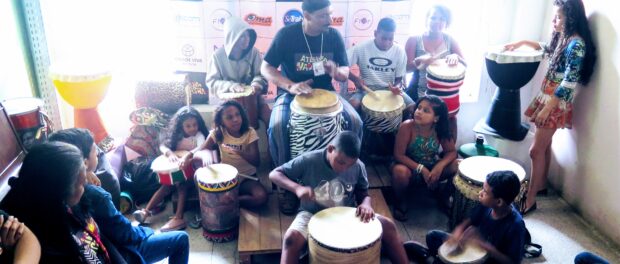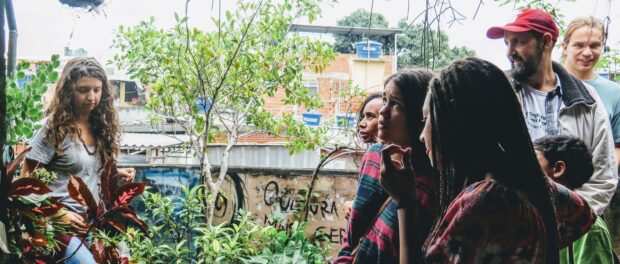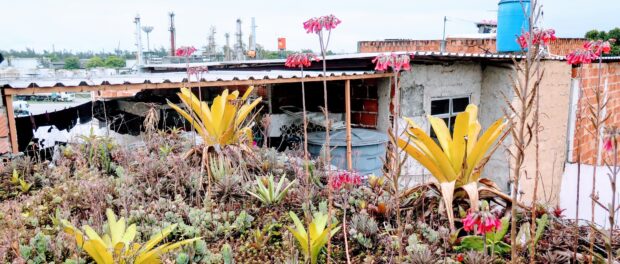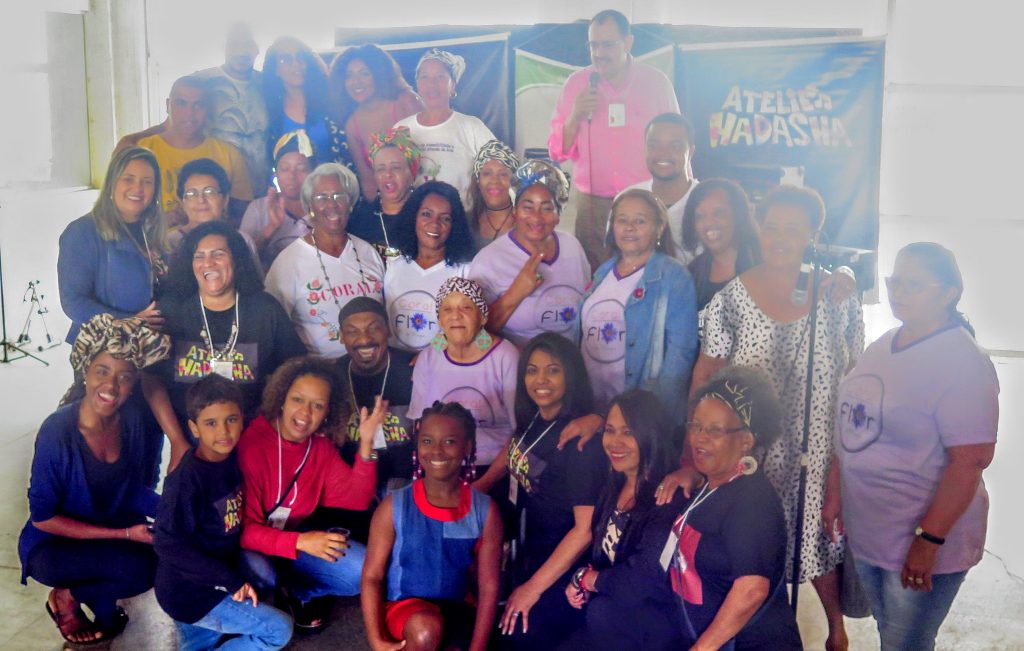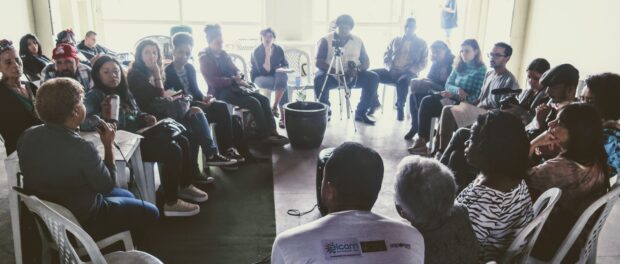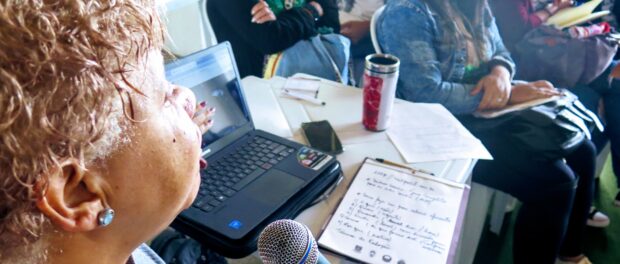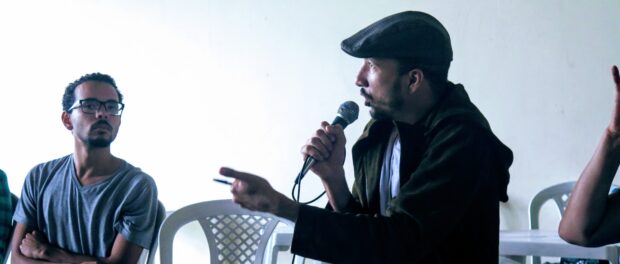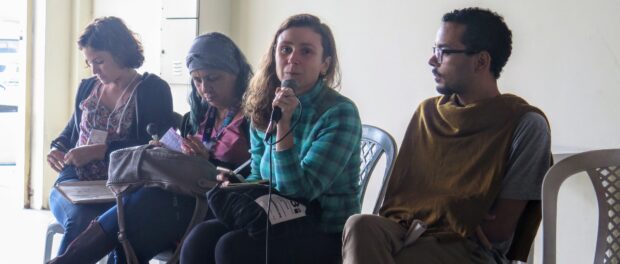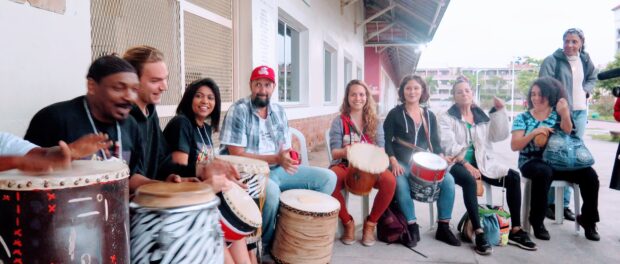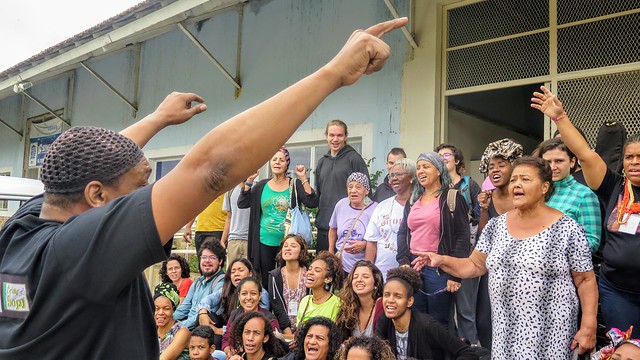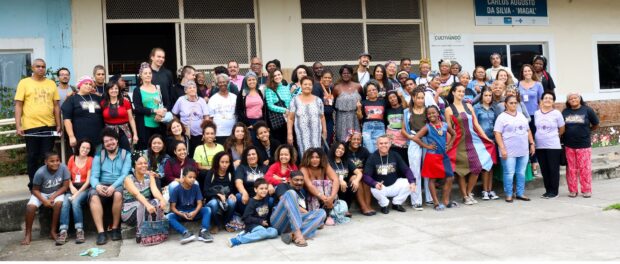
The Sustainable Favela Network (SFN) is a project of Catalytic Communities (CatComm)* designed to build and reinforce solidarity networks, bring visibility and develop joint actions to support the expansion of community-based initiatives that strengthen environmental sustainability and social resilience in favelas across the Rio de Janeiro Metropolitan Region. The project began with the 2012 film Favela as a Sustainable Model, followed in 2017 by the mapping of 111 sustainability initiatives and the publication of a final report analyzing the results.
In 2018, the project organized intimate on-site exchanges among eight of the oldest and most established organizations that were mapped in the Sustainable Favela Network, followed by a full-day exchange with the entire network that took place on November 10, 2018. Watch the video that accompanies the exchanges featured in the 2018 series by clicking here.
In 2019, the project has realized the second round of on-site exchanges—this time open to both SFN members and the general public alike—at projects based in Babilônia, Camorim, Pavuna, Vila Kennedy and Manguinhos. In this fifth and final exchange of the year, participants gathered at the Manguinhos Worker’s House in Rio’s North Zone. The day began with a symbolic tree-planting, followed by a narrated history of the Hadasha’s Workshop initiative, and a walk to the Green Roof Favela project in nearby Parque Arará. Following a musical lunch and a sustainable fashion show, courtesy of the Talented Hands sewing collective, the day’s participants engaged in a training session on communication, media viability, and social media strategies for community projects, closing the day with a drum circle. All SFN exchanges are supported by the Heinrich Böll Foundation Brazil.
A Musical Welcome
On the morning of September 29, 88 people gathered at the Casa do Trabalhador (Worker’s House), located in the favela of Manguinhos, in Rio de Janeiro’s North Zone. The building—a state government project designed to provide job training and support for Manguinhos residents—would host the fifth and final Sustainable Favela Network (SFN) Exchange of 2019. Kicking off the day, participants were invited to partake in a tree-planting ceremony, rooting a young starfruit tree in the grass in front of the House, accompanied by the sounds of the drums of Guilherme Hadasha, founder of the Ateliê do Hadasha (Hadasha’s Workshop) project, in homage to mother nature and as a symbolic protest against the deforestation of the Amazon.
Following the planting, inside the House, Catalytic Communities (CatComm) director Theresa Williamson reminded the group of the SFN’s purpose as a community-based network designed to strengthen favela projects focused on socio-environmental solutions. Williamson concluded that the exchanges demonstrated that the “potential of favelas as sustainable models is palpable!” This potential manifests itself in, for example, the Teto Verde Favela (Green Roof Favela) project, created in nearby Parque Arará in 2014 by Luis Cassiano Silva with help from students from the Enactus organization at the Federal University of Rio de Janeiro (UFRJ). Silva, known by his nickname “Careca”, sought to reduce the impact of the heat island that had formed in Parque Arará by seeding a layer of plants atop his house. The move worked, making the area cooler and more livable.
Another example of the potential for favelas as sustainable neighborhoods is the Hadasha’s Workshop project, founded in 2010 in Manguinhos by musician, professor, and artisan Guilherme Hadasha. Hadasha moved to the North Zone in his youth and enlisted in the military upon turning 18. Despite discrimination, Hadasha took to studying classical music and continued to practice it throughout his adult life. “Music appears in our lives as a source of hope, resistance,” explained Hadasha. On leaving the military, Hadasha continued on his musical path, achieving success and playing all over the world.
Hadasha would later return to the Manguinhos community, living in the house of his deceased mother, and, after having coordinated several different musical projects, together with a small team that includes his son Jefferson, developed the Workshop project at the Worker’s House. Hadasha’s Workshop creates musical groups centered in environmental sustainability, developing techniques for crafting professional-quality drums out of repurposed materials. The Workshop is a “cultural school,” based in the central belief that “art has no color,” and that art should be open to all. Hadasha emphasized to the day’s group that, in the Workshop “we are not focused on training musicians, we are solely [providing] opportunities for children to find themselves as citizens.”
Sustainable Drums
Hadasha then invited participants to gather around him and learn of the history of his drums. Showing his gratitude, Hadasha began reminding the group that “an animal died [for us] to be able to play music, dance, and sing,” as drums—ancestral, mythic instruments, present around the world—are made from the skin of animals.
Given their cost, professional quality instruments are inaccessible to many in low-income communities. For this reason, Hadasha encourages each of his students to build his or her own drum. Hadasha’s drums, however, are special: they are made from recyclable materials like glass, metal, plastic, and paper. In reference to the Brazilian musician and composer Hermeto Pascoal, Hadasha told the group “all materials that produce sound can become musical.” And so, using simple, everyday materials such as PVC pipes, water jugs, traffic cones, and lamps, Hadasha’s Workshop produces a variety of drums.
The Workshop is also local and self-sufficient: companies donate materials, and Hadasha’s students come to the Workshop once a week to learn to build their own drums, take classes on music theory, practice music, and learn about black history and its musical contribution to Brazil. Not only do students learn music from start to finish, but they also learn to sell their crafts in local fairs, such as Rio’s EcoSol solidarity economy fair. But with his “alternative music,” Hadasha believes he stimulates conversations that go beyond: the workshop has the potential to move participants to reconsider the meaning of trash and to give value to materials within their own communities. Following an energetic drum circle featuring Hadasha and his students, the first presentation came to a close.
Green Roofs
Following a twenty-minute walk to the lively streets of Parque Arará, led by student volunteers from Enactus, participants discovered the incredible house of Careca, where the Green Roof Favela project began. “Careca, you’re crazy. This project of yours won’t work. It’s only going to bring problems,” Parque Arará residents had said in 2014, according to Careca, when he began to build his green roof with the help of Bruno Resende. Now, climbing a series of spiral steps at his house, the fruits of his labor are plain to see: inspired in models implemented around the world, Careca’s plant-based roofing gathers more than 50 species of plants, all of them adapted to Brazil’s tropical climate.
The results are impressive. The green roof provides substantial thermal protection, lowering the temperature of Careca’s house by up to 15°C (~27°F) in comparison to its surroundings. His roofing also improves air quality, and the plants bring birds along with them, as well as the potential for plant-based alternative medicine. According to Careca, the benefits of plants are not only social and environmental, but also economic and emotional. The day’s group left Careca’s house enchanted.
A Festive Lunch
Returning to the Worker’s House, participants shared a lunch prepared by Hadasha’s Workshop, adhering to one of the SFN exchanges’ major goals: reducing waste production. For that reason, each participant was asked to bring his or her own bowls and utensils. Musical presentations accompanied lunch, featuring Hadasha’s student drum group, his son Jefferson on the guitar, and, finally, the singer-composer Lira, accompanied by the Flor de Mangue (Mangrove Flower) Choir, a musical initiative made up of mothers and grandmothers of the children that participate in Hadasha’s Workshop. Closing lunch, volunteers from the Mãos de Talento (Talented Hands) sustainable sewing workshop paraded their latest creations, fashioned out of recycled and repurposed materials.
Media Visibility, Social Media Strategies, Working with the Press
In the afternoon, Williamson led a capacity-building circle featuring presentations from three other SFN members. Based on the idea that “everyone has knowledge to share,” the circles are a space for exchanging experiences between Network members, based on topics of interest identified at the Network’s launch in November of 2018.
The theme chosen for the fifth and final exchange of 2019 was communication, with a specific focus on social media and press engagement for community projects. Opening the discussion, Williamson clarified the concept of social media. “What we call ‘media’ is nothing more than content produced and a public that receives it, only 15 years ago it was prohibitively expensive to produce and share content with a large audience, so the ability to produce and share media was monopolized.” Today, in comparison, “anyone can produce content online and, if it’s exciting, develop it and bring it to a large public, at virtually no cost.” For Williamson, when it comes to favela-based community organizations and movements, social media represents a true revolution in terms of its potential for projecting their voices, concerns and solutions. She thus posed the following question to the circle’s presenters: How can this novelty be put to use for developing community projects?
Edna Thomaz Rodrigues, from the African Diaspora Ancestral Commemoration Institute (ADACI), which works with the question of ancestrality and the history of black people in the Americas, shared her experience working with the Jornal do Brasil newspaper and the Rádio Cidade station, before moving on to the harmful and beneficial roles of social media. Despite issues of fake news, social media networks can provide broad visibility for communities. Rodrigues recommended the use of Facebook for work in communities, as it allows for an easier blending of text and images, as opposed to Twitter and Instagram.
Next, Thainã de Medeiros, museum curator, journalist, and member of Coletivo Papo Reto (Straight Talk Collective), a human rights group based in the favelas of Complexo do Alemão, in Rio’s North Zone, discussed the issue of communication in relation to human rights inside favelas. The collective developed in response to extreme rains at the end of 2013, which had devastated houses in Complexo do Alemão. On seeing that Rio’s Civil Defense organ refused to come and evaluate the houses’ collapse, activists developed a new communication methodology. With the creation of Coletivo Papo Reto in 2014, the organization Witness entered in contact and trained members in their methodology. Witness’ approach is based on the idea that human rights abuses can be prevented by placing an institution’s public image in check. The collective adapted the methods and mixed them with their local know-how.
As a result, cell phones became true allies for residents, who were able to gain quick visibility on social media. The use of cell phones allowed activists and residents to film human rights abuses, not only gaining media attention, but also providing evidence for use in court. Medeiros ended his talk reminding participants of the risk associated with this type of communication, in that one can end up “speaking only of violence and nothing else.” For Coletivo Papo Reto, a solution to this type of problem is the development of a “cultural festival, to speak of the good things in favelas.”
Continuing the discussion, Danyelle Fioravanti, a social cause communications specialist with more than ten years’ experience with social media, summed up her experience, presenting the following points:
- Place your topic of focus on the agenda at public events in order to reach decision-makers, inactive stakeholders, and the general public.
- Reflect on the composition of your target audience.
- Tell stories that capture the public interest, as is done through TED Talks.
- Believe in the survival of ideas, as seeds planted for the future.
- Recognize communication as a form of dialogue, a continuous exchange.
- Finally, remember that social media networks are only tools; mobilizing people remains essential.
Last, Williamson discussed the example of mobilizing international media and the case of RioOnWatch. Created in 2010 by CatComm, RioOnWatch‘s central goal is to document and report the context, development, and conditions of Rio favelas, publishing in Portuguese and English. In the lead-up to the 2016 Olympic Games and with a strong presence of international media outlets, RioOnWatch began to work with international journalists as well in order to change the narratives surrounding Rio’s favelas, emphasizing, for example, the difference between the word “slum” in English and the Brazilian reality of its “favelas.”
This work produced clear results: as measured through a multi-year study, the voices of residents of favelas gained increased visibility, among other things showing that violence in Rio was not committed solely by drug traffickers, but by the State as well. However, it is vital to remember that the press can easily distort resident discourse on their own communities. Williamson thus advised that each resident keep in mind the exact message they wish to transmit when speaking to the press and focus on this message. Williamson closed her talk pointing out that community journalism and Solutions Journalism are new movements, and that both can contribute to the process of giving value to favela initiatives.
Winding down the day, participants joined Hadasha in one final drum circle.
Check out our full album of the day’s events (or click here):
*Both the Sustainable Favela Network and RioOnWatch are projects of Catalytic Communities.

